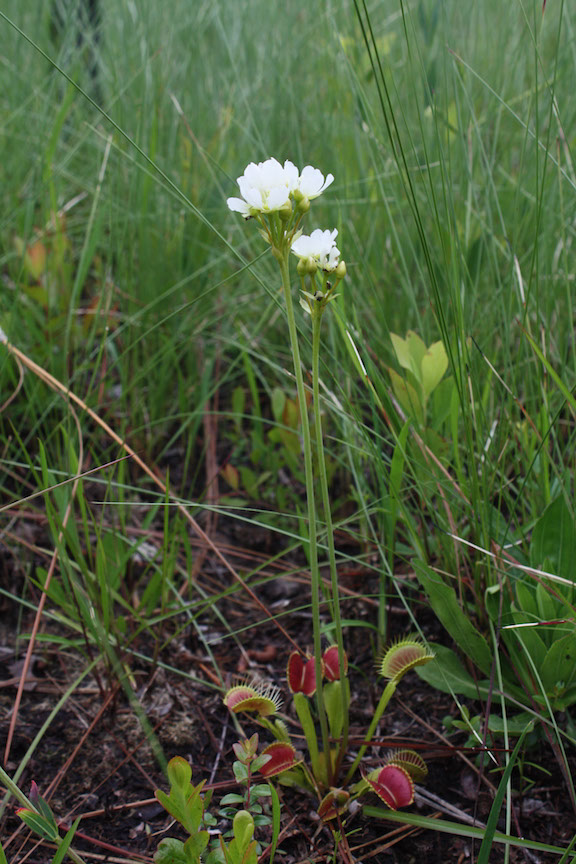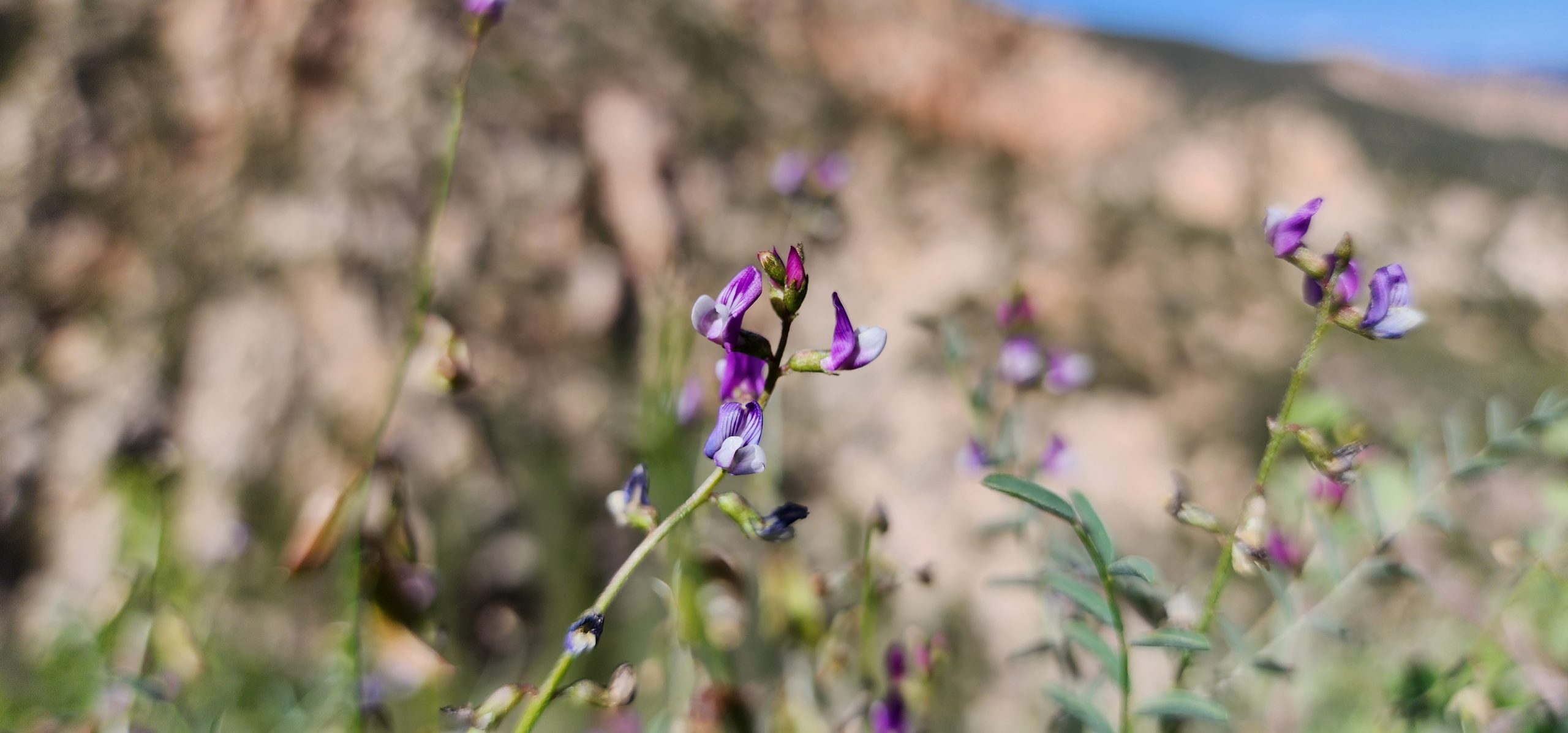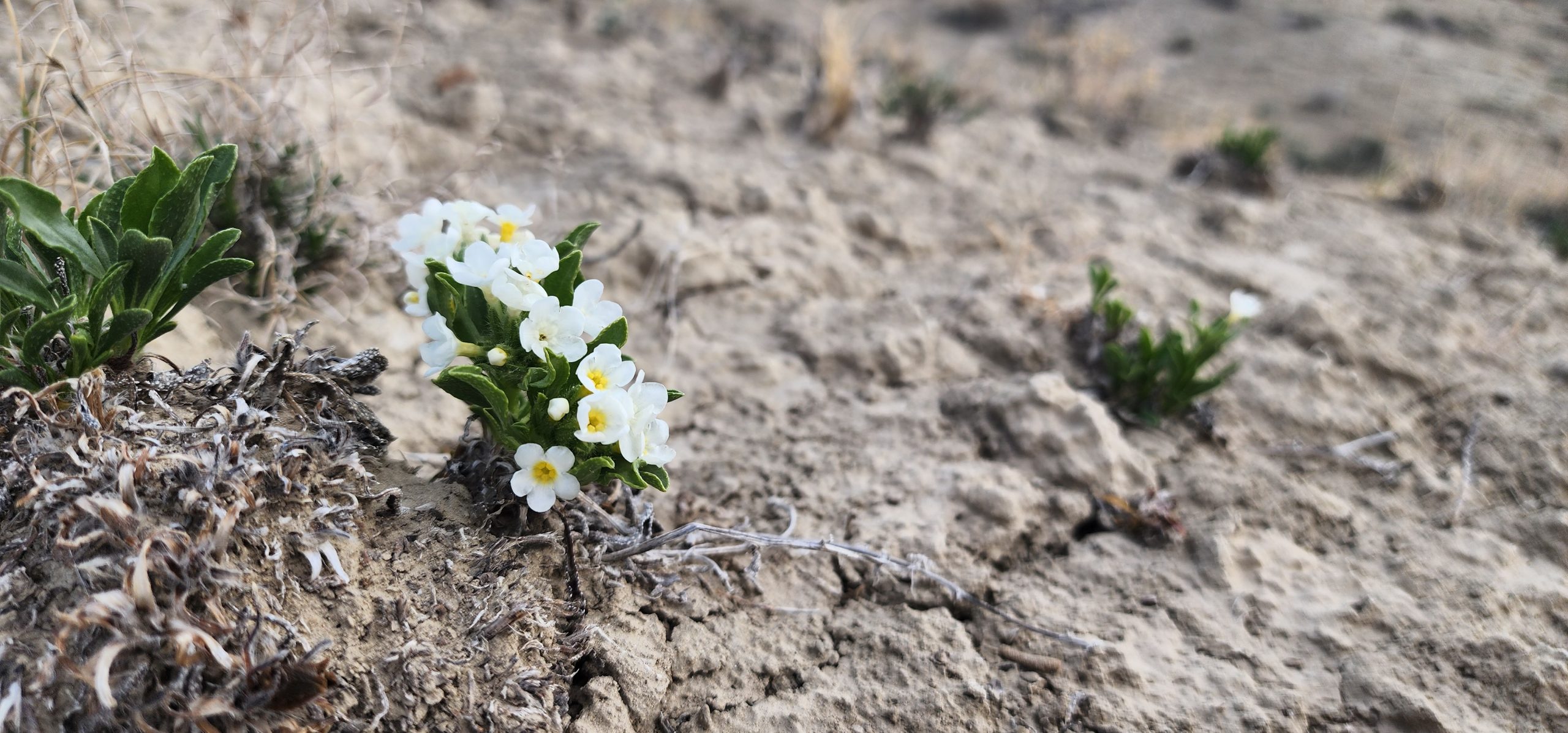SAVE PLANTS
Center for Plant Conservation
In the plant world, perhaps none are as wonderous and fascinating as carnivorous plants—nature’s intrepid hunters. These charismatic plants have long sparked our curiosity with their unique adaptations for survival, and many people might be surprised to learn that the United States is home to a variety of rare and endangered carnivorous plant species, with many found throughout the Southeast and even in California. The CPC National Collection includes 12 species of imperiled carnivorous plants—from striking pitcherplants and flowering butterworts to the iconic Venus’ flytrap (Dionaea muscipula)—a testament to the incredible diversity of North American native flora and the urgent need to protect them. CPC Conservation Partners are working tirelessly to conserve these plants, from making seed collections and reintroductions into the wild to conducting propagation and genetic research to understand how best to steward these species and ensure their long-term survival.
In this issue of Save Plants, we highlight these extraordinary carnivorous plants and the conservation efforts underway to save them from extinction. Discover the work of the San Diego Zoo Wildlife Alliance, home to an extensive collection of carnivorous plants from the U.S. and beyond, and learn about North Carolina Botanical Garden’s ongoing conservation work with Venus’ flytrap in our Rare Plant Academy spotlight. From the Save Plants archive, we’re sharing an April 2023 feature on Atlanta Botanical Garden’s legacy efforts to monitor and restore Georgia’s rarest habitat—mountain bogs—and imperiled plants found there like the state-listed Mountain purple pitcherplant (Sarracenia purpurea var. montana). Additionally, we celebrate this month’s Conservation Champion, Michael Kunz of North Carolina Botanical Garden, whose tireless stewardship of rare Southeast species, including several carnivorous plants, continues to drive forward our shared mission to protect biodiversity.
Together, through collaboration and a commitment to conservation, we can safeguard these remarkable plants and ensure their survival for generations to come. We thank you for being part of our conservation community!
Sincerely,
The CPC National Office Team
Carnivorous Plants at the San Diego Zoo Wildlife Alliance
Carnivorous plants are one of the marvels of the plant world. Carnivory has developed independently in 15 plant families (3 monocot and 12 dicot) with over 580 species described and new species being discovered each year. These unusual plants can be found on all continents except Antarctica growing in nutrient poor soils, requiring these plants to develop alternative means for acquiring nitrogen and phosphorous needed for metabolic processes. Modified leaves primarily trap insects, or in the case of aquatic plants, protozoans.
Carnivorous plants have devised several types of traps to capture prey: pitfall, snap traps, fly paper, lobster pots and bladder (vacuum). Passive traps rely on sticky or slippery surfaces to cause prey to stick or slide into the digestive fluid. Pitfalls, such as those found in Nepenthes, Heliamphora, and Brocchinia rely on slippery surfaces; while Drosera, Pinguicula, and Drosophyllum are examples of genera that depend on flytraps – sticky glandular hairs that coat prey with mucilage. Lobster traps are leaves that use hairs to prevent prey from exiting once they are lured into the trap. This type of trap is found in Genlisea. Bladder traps are only found in Utricularia, an aquatic genus of carnivorous plants, where a bladder uses a vacuum to suck protozoans into the trap. Active or “snap” traps are found in Dionaea and Aldrovanda. Trigger hairs signal when it’s time to snap shut on unwary prey. In each case, specialized cells in the leaf excrete digestive fluids that break down the prey and are then reabsorbed into the leaf.

Despite the occurrence of carnivorous plants in many areas of the world, many are under threat due to habitat loss, climate change and illegal collection from the wild. At the San Diego Zoo Wildlife Alliance (SDZWA), the horticulture department has developed a robust collection of carnivorous plants, with over 90 species from several families, and new additions being acquired annually.
The majority of our collection is comprised of Nepenthes species, with many of them ranked from vulnerable to critically endangered. Twelve of the Nepenthes species under our care are listed as critically endangered by IUCN. Three of the most endangered Nepenthes in our collection are:
- N. khasiana is the only species native to India where it occurs in isolated populations. An endangered species, Nepenthes khasiana produces a sweet nectar that also contains a disorienting neurotoxin that increases the likelihood of prey falling into the trap. This species also fluoresces on its peristome and underside of the lid as a method of attracting prey.
- N. aristolochioides is a species endemic to the highlands of Sumatra and is critically endangered due to overcollection. The mouth of the pitcher is held at an almost vertical angle, and the digestive fluid inside is thick and syrupy.
- N. clipeata: an extremely rare species found only on Mt. Kelam, Borneo. Populations of this beautiful species have been drastically reduced by fires and overcollection. With few mature specimens left in the wild, it is feared this species is functionally extinct in its native habitat.
Our efforts in the SDZWA horticulture department are aimed at cultivating a diverse and healthy ex situ population of these rare species against the threat of extinction. As our specimens mature, we hope to participate in breeding programs with partner institutions to ensure the genetic diversity of each species is preserved.
As part of our public outreach, we have collection specialists set up displays and discuss our work at monthly Plant Days and Wild Weekends, as well as give presentations in our summer camp program and to other groups. Our collection has been featured on TV and podcasts. Those in San Diego wishing to learn more about these unique plants can visit the Zoo on the third Friday of every month to see them up close and ask the horticulture team any questions about all things botanical.
-

Drosera in the San Diego Zoo Wildlife Alliance's collection. Photo credit: Adam Painter. -
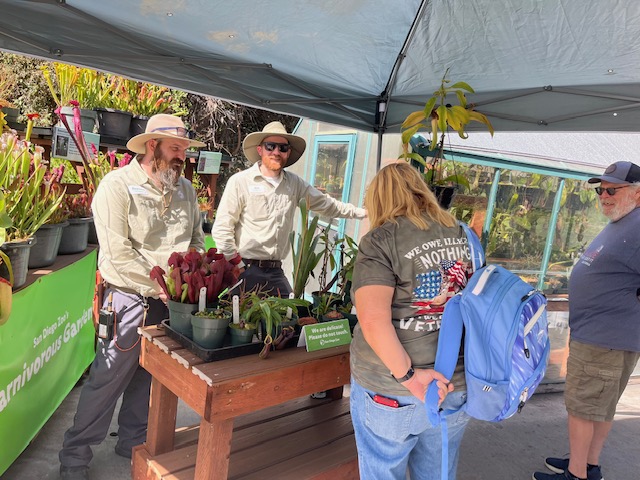
SDZWA horticulture team members talking with guests about their carnivorous plant collection at a Plant Day event, which typically engage 600-700+ guests during these monthly events. Photo courtesy of the San Diego Zoo Wildlife Alliance. -

Nepenthes in the San Diego Zoo Wildlife Alliance's collection. Photo credit: Adam Painter.
From the Archive: Best Practices Enhance Atlanta Botanical Garden’s Legacy Work with Mountain Bogs
This story was originally featured in the April 2023 Save Plants newsletter.
The Atlanta Botanical Garden’s Southeastern Center for Conservation staff work to monitor and restore some of the most imperiled plants and habitats of the southeastern United States. Prior to initiating restoration, Center scientists conduct rigorous research to identify optimal targets and assess the benefits for rare plant species. The Center’s conservation horticultural team then supports ecological restoration through augmentation or reintroduction of appropriate material. Field ecologists track survivorship and support ongoing management and recovery efforts. Some of these methods can be traced back to our early work, while others are more recently being implemented to support and enhance legacy projects.
For 30 years, Atlanta Botanical Garden (ABG) has provided ex situ conservation and in situ guidance to support the implementation of successful efforts in Georgia’s rarest habitat—mountain bogs. Safeguarding these wild treasures in the 1990’s led to the formation of the Georgia Plant Conservation Alliance (GPCA) and with other founding members, we have worked together to restore these and other high-priority habitats identified in Georgia’s State Wildlife Action Plan.
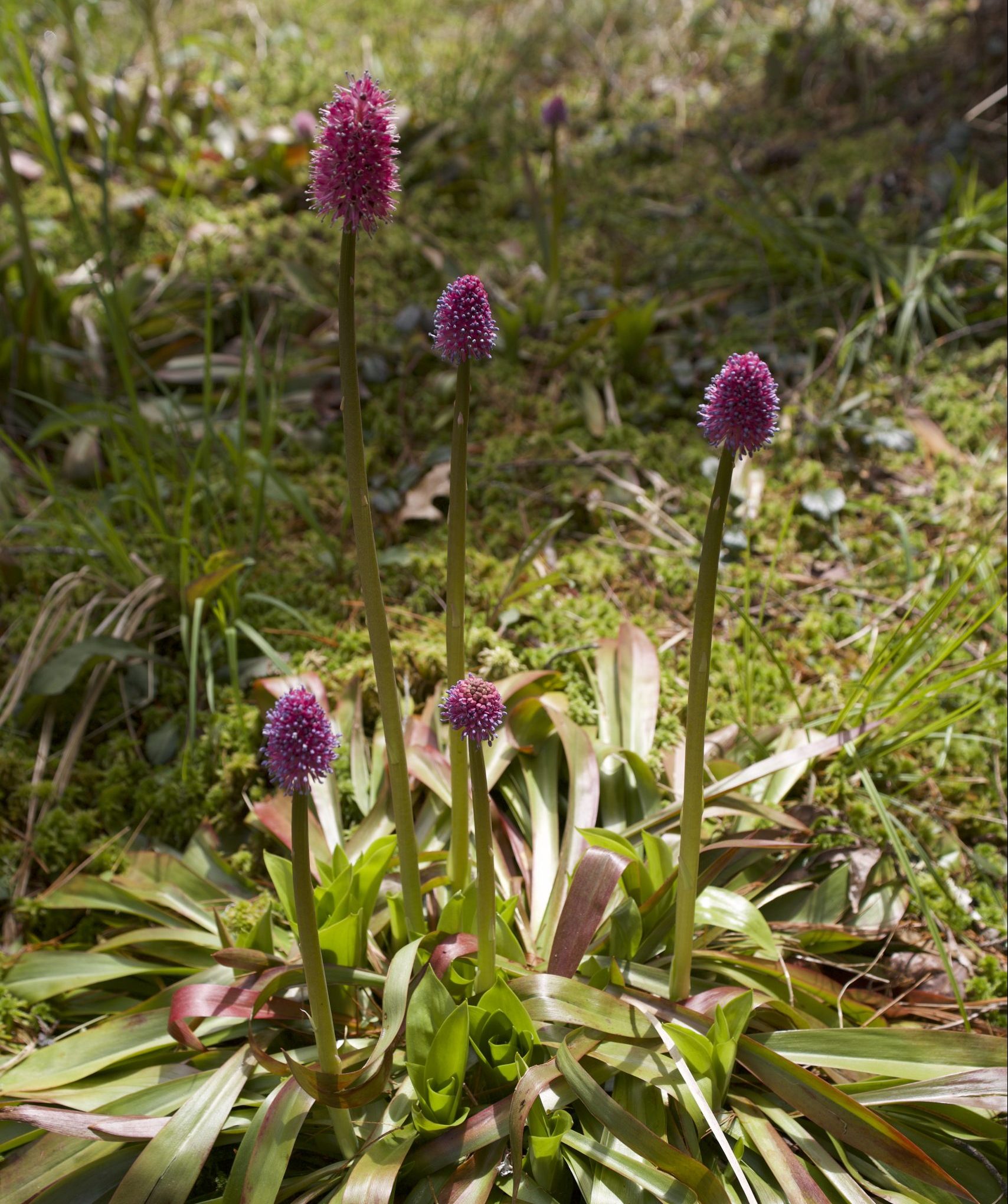
Georgia’s mountain bogs are early successional communities that support a variety of imperiled organisms. These include the federally endangered swamp pink (Helonias bullata), as well as the state-listed purple pitcher plant (Sarracenia purpurea var. montana). Relatively few high-quality sites remain in Georgia, but a high proportion of those are found on public land. An essential part of our conservation work has included propagation of rare plants from wild populations and reintroduction of this material into suitable habitat, as well as routine habitat maintenance and monitoring. ABG also leads the coordination of annual meetings to review accomplishments, set goals, coordinate work, and share data. Our current focus includes monitoring and remediation efforts following disturbance from feral hogs (Sus scropha) and exclusion to prevent additional damage; maternal line seed collection and banking; conducting and planning genetic research; and habitat management assessments and planning.
The first attempts at rare plant reintroduction in Georgia’s mountain bogs involved safeguarding swamp pink and mountain purple pitcher plants. These taxa are wild at only two locations, including a remote site on the Chattahoochee National Forest containing only the pitcher plant and a privately-owned bog that once supported both species but has lost ecological integrity following severe hydrologic alteration. Reintroduction into suitable habitat on protected lands has been conducted with the goal of creating experimental populations and spreading the risk of extirpation among multiple sites.
More than 500 individual mountain purple pitcher plants have been used to establish 7 experimental sites since 1997. Recruitment has been documented at 5 of those sites. The original wild population has been augmented with more than 200 additional individuals since 1995. Fruit set, the first known from Georgia in decades, was documented there in 1999. In 2000, the first seedlings were noted. A 2013 census indicated multiple generations of plants, flowering recruits, and over 400 total individuals. A 10-year site assessment and population inventory in the fall of 2023 will inform the first maternal line seed collection for this species in Georgia. This material will be banked and could be used for future augmentation and reintroduction work, guided by the results of a population genetics study currently underway at ABG for this species.
Similar safeguarding efforts have established new populations of swamp pink at 4 protected bogs. Since 1997 over 400 individuals have been returned to the wild—most in the experimental sites. The first flowering of this species in a created population (2010) and the resultant seedlings (2011) represented the first documented seedling recruitment of this species in Georgia. There are now multiple generations of this species in multiple sites on protected and appropriately managed land, which was the ultimate goal. More recent outplantings have been individually tagged. ABG began maternal line seed and leaf sample collections for swamp pink in 2020, and this material has also been added to ABG’s Conservation Seed Bank and DNA Biorepository, respectively.
Cooperative management has been the key to successful establishment and independent reproduction in both wild and experimental sites. Management activities have included manual and mechanical removal of woody vegetation in ecotones (transition zones) between the wetland and upland habitats, invasive exotic plant treatment, prescribed fire, and exclusion of invasive hogs. These activities have been critical in preventing damage to sensitive sites, reducing competition, and decreasing shading and evapotranspiration to maintain integrity, sunlight, and moisture. Vegetative growth, flowering, seed production, and seedling recruitment have increased for both swamp pink and purple mountain pitcher plant following management events. These collaborative efforts likewise support the state listed Southern bog turtle (Glyptemys muhlenbergii), which also relies on captive rearing to supplement and reinforce the limited number of fragmented populations remaining. These examples illustrate how reintroducing rare plants can have complementary benefits to other species and that reintroduction itself is not sufficient—ongoing site management is required to successfully reestablish and maintain thriving in situ populations.
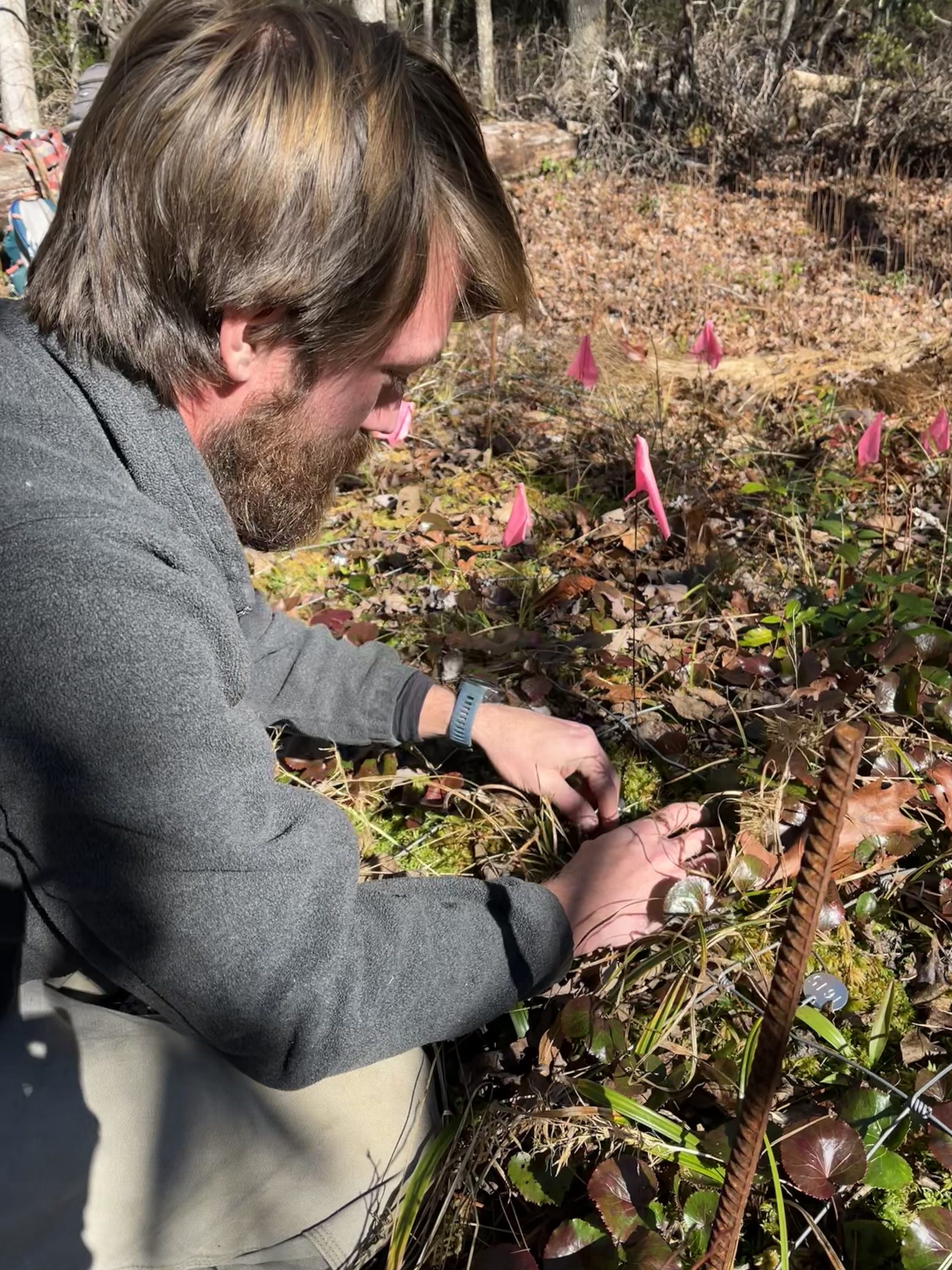
ABG maintains a database on behalf of GPCA that houses information on rare plant conservation activities. This provides a central repository to track ex situ collections, in situ augmentations/reintroductions, monitoring data and survivorship analysis, and collaborative management actions for priority species. This system was developed using the suite of mountain bog species and sites and has been essential in coordination and evaluation of key actions for collaborative projects. The success of these efforts are serving as models of success for the Bog Learning Network(BLN) and the Southeastern Plant Conservation Alliance (SE PCA). Applying and updating the Center for Plant Conservation’s Best Practices Guidelines helps to ensure the survival of these species and their habitats in the wild, while documenting successes and steps to improve outcomes helps to refine best practices and promotes their importance and use in other networks.
-
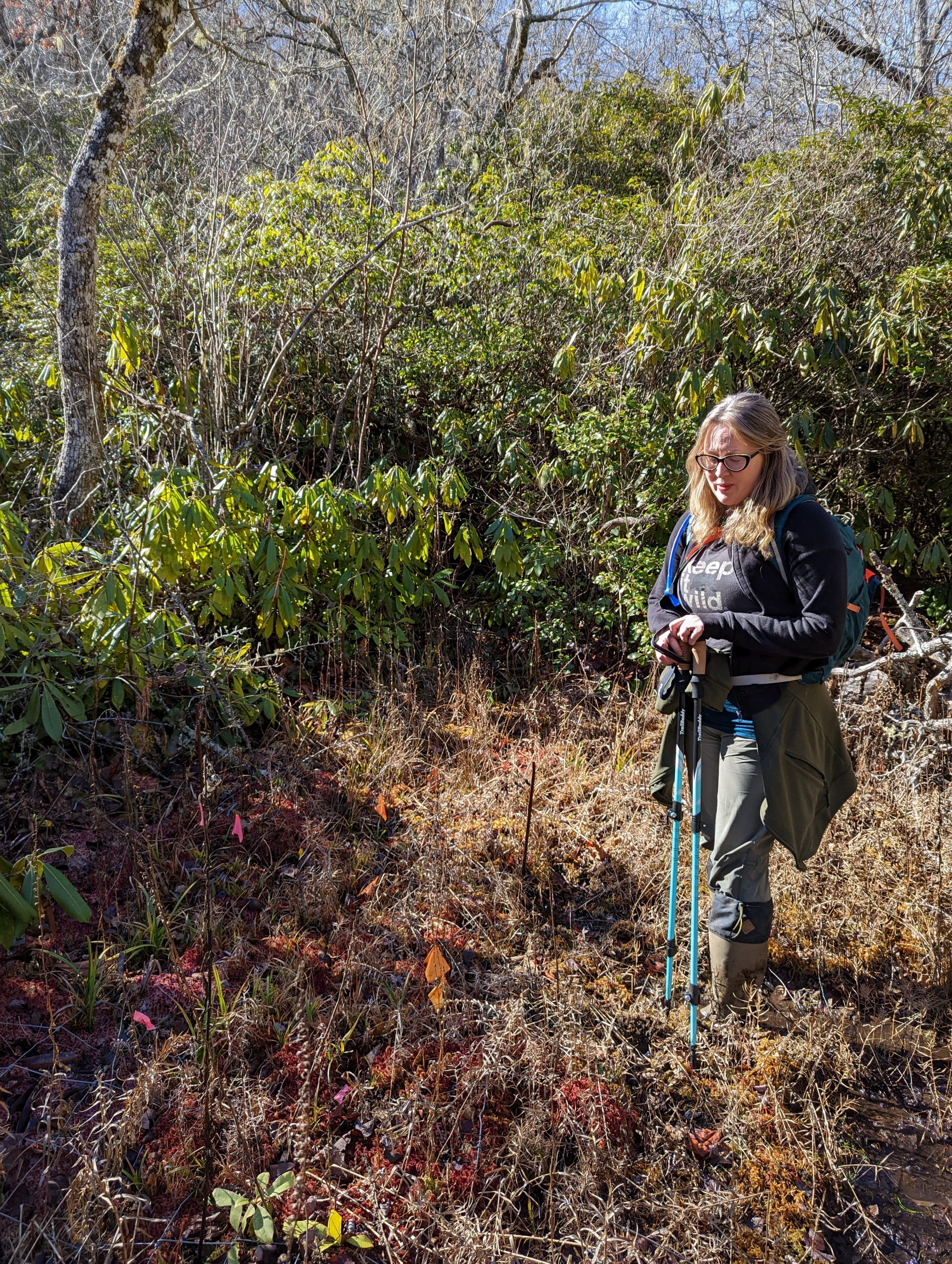
Carrie Radcliffe monitoring establishment of outplantings in areas caged to exclude feral hogs. Photo by Will Hembree. -
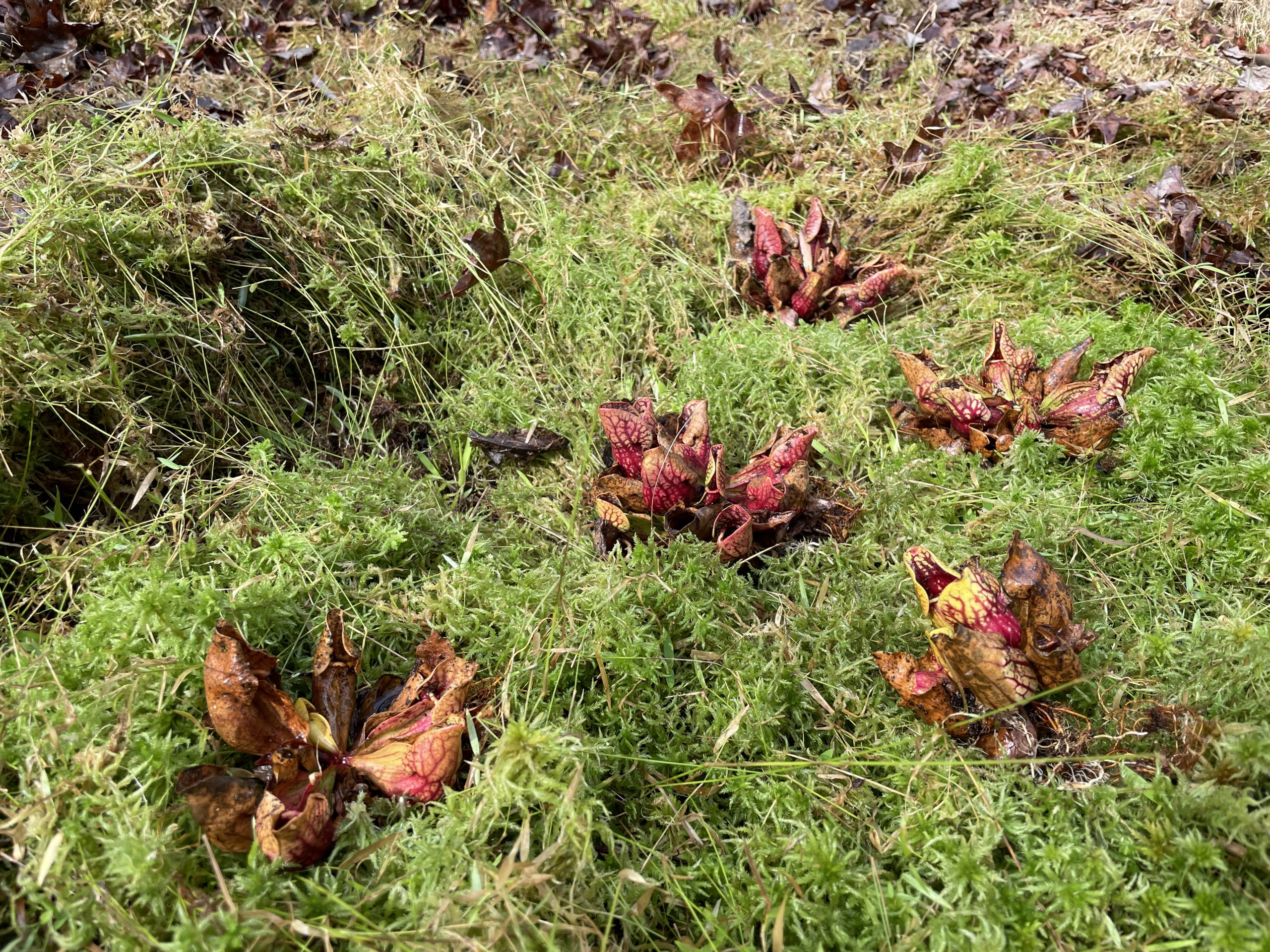
Outplanting mountain purple pitcher plants at a protected site with suitable habitat within the native range with Carrie Radcliffe. Photo by Madison Ohmen. -
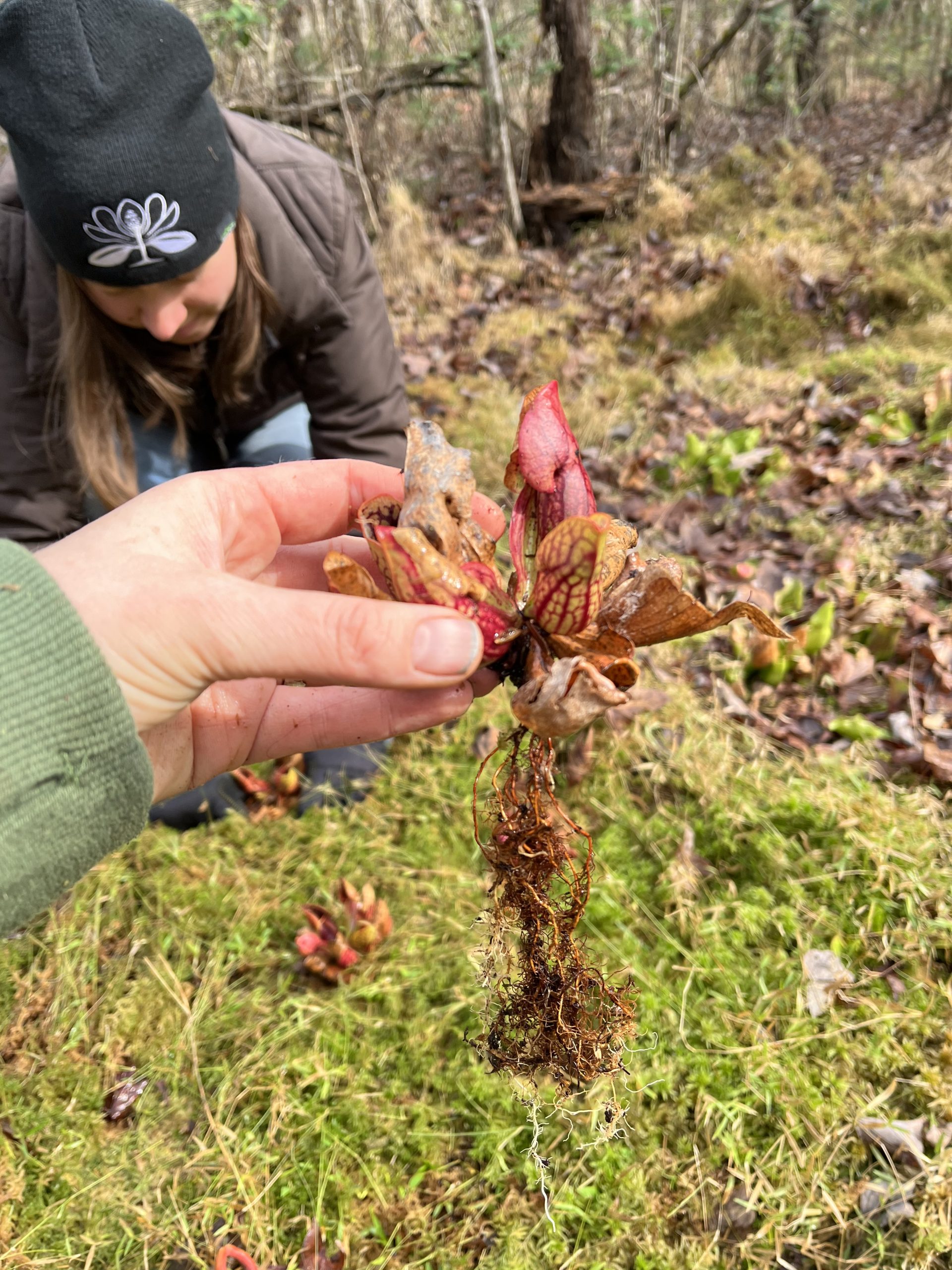
Montane purple pitcher plants being planted in an existing experimental wild site by Madison Ohmen and other Garden staff. Photo by Carrie Radcliffe.
Michael Kunz
Our October Conservation Champion, Michael Kunz, brings his love of nature and plant ecology to his role as Director of Conservation Programs at the North Carolina Botanical Garden. A long-time CPC Conservation Partner, Mike has been instrumental in the stewardship of rare species in the Southeast, including several imperiled carnivorous plants. His dedication and leadership continue to advance our shared mission to protect biodiversity, ensuring these unique and vital plants are preserved for future generations. Mike’s work exemplifies the critical role of engagement and collaboration in preventing plant extinction and safeguarding our planet’s natural heritage. As Mike shares, “The more we build a society that values plants at all levels, the more likely we are to advocate for their conservation.”
When did you first fall in love with plants?
Plants were part of my life pretty early. I gardened with my mom and we spent a lot of time camping and hiking in the Colorado Rockies, often stopping to admire wildflowers and examine the trees. But it was a general botany course at the University of Colorado, Boulder where I really realized how much I loved plant ecology. Every part of that class really connected with me and I found something I was very passionate about.
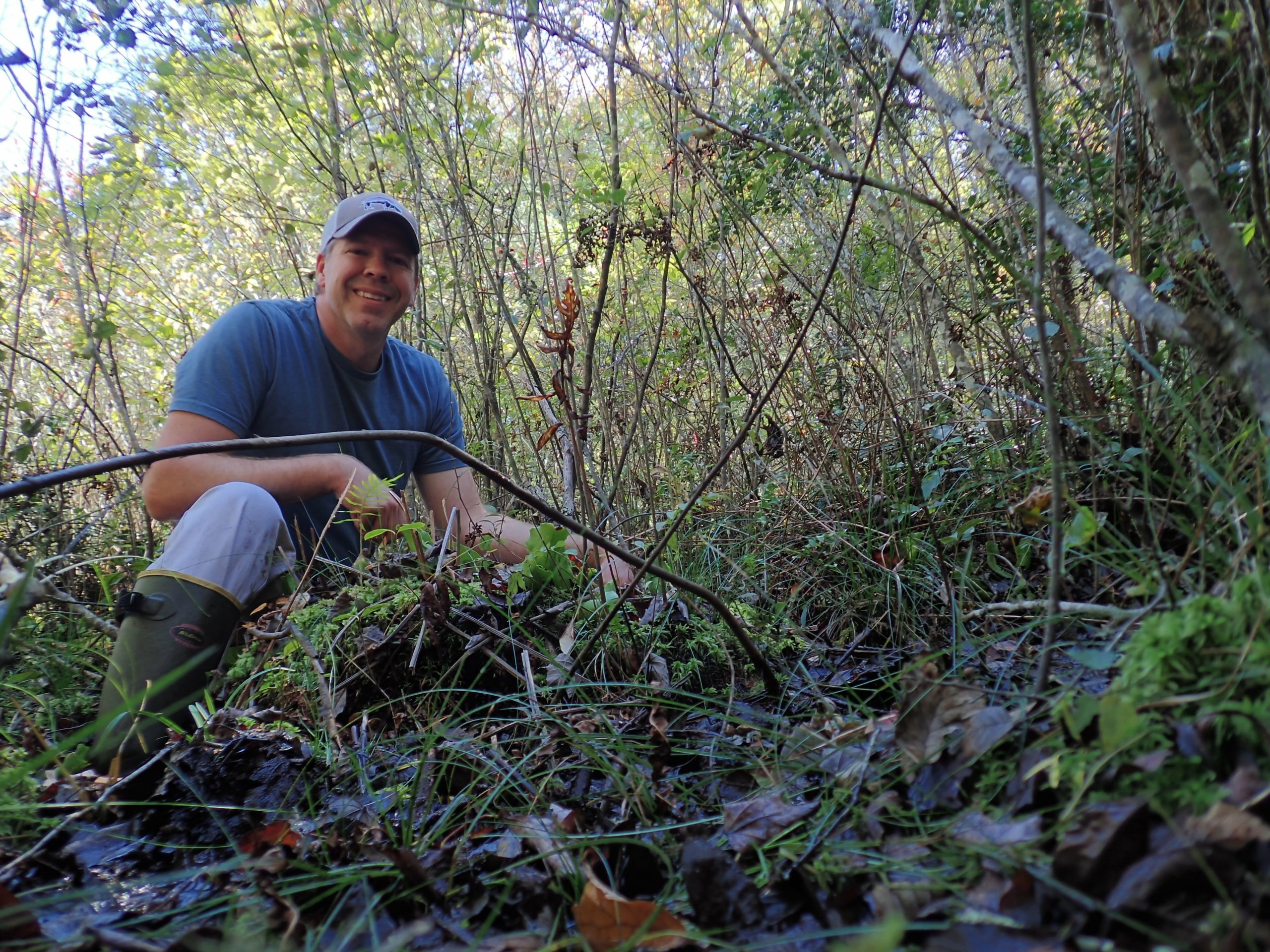
What was your career path to your career at North Carolina Botanical Garden?
After my botany course I started looking for any job I could find that was plant related. I sorted tundra plants for researchers, volunteered for invasive species pulls, worked for county extensions, conducted research in desert grasslands of Arizona – the list goes on and on. After a short stint as a high school teacher, I moved to North Carolina and started at NCBG as an ecologist. My path there also drifted from land stewardship to rare plant conservation. I was lucky enough to have a supportive environment to allow me to grow and do more rare plant work, eventually leading to my PhD program (Environment, Ecology and Energy Program, University of North Carolina at Chapel Hill) and becoming the Director of Conservation at NCBG.
Based on your experience, what are some of the pressing conservation needs impacting imperiled plants, including carnivorous plant species, in North Carolina and the Southeastern U.S.? How has your (or your institution’s) work addressed them?
Land use changes, including direct loss of habitat, and fire suppression are two of the biggest threats to many species in the Southeast, including carnivorous plants. On top of this, I am a firm believer in that we need to know how these changes, and those associated with climate change and management decisions, are actually impacting populations and species. For many rare species, we don’t actually know how species are responding to this rapid global change and until we do, finding ways to balance societal and ecological needs is really difficult. This is all very true for carnivorous plants in the Southeast where land continues to be converted into development and agriculture, hydrology is changing, and people and climate change are altering the fire regime.
What conservation projects are you currently working on? What successes or challenges have you encountered in your work?
A new project we are a part of is looking at how Venus flytrap populations are likely to respond to changing climate and fire factors and translating the results to partners so they are better equipped to manage flytraps and other rare species in the future. This is a collaboration with Kansas State University and Duke University with funding from the National Science Foundation and the Paul G. Allen Family Foundation’s Partnership to Advance Conservation Science and Practice. This is a great collaboration that allows all the partners to continue advancing our knowledge and conservation action to help plant conservation.
What has surprised you about working with and learning more about rare plants?
For me, one of the biggest challenges is how little we know about so many rare plants and how little material we have to work with to follow best practices. But this is also one of the things that keeps me engaged and working to fight extinction. Even in the smallest number of plants we can deepen our understanding of these intricate connections.
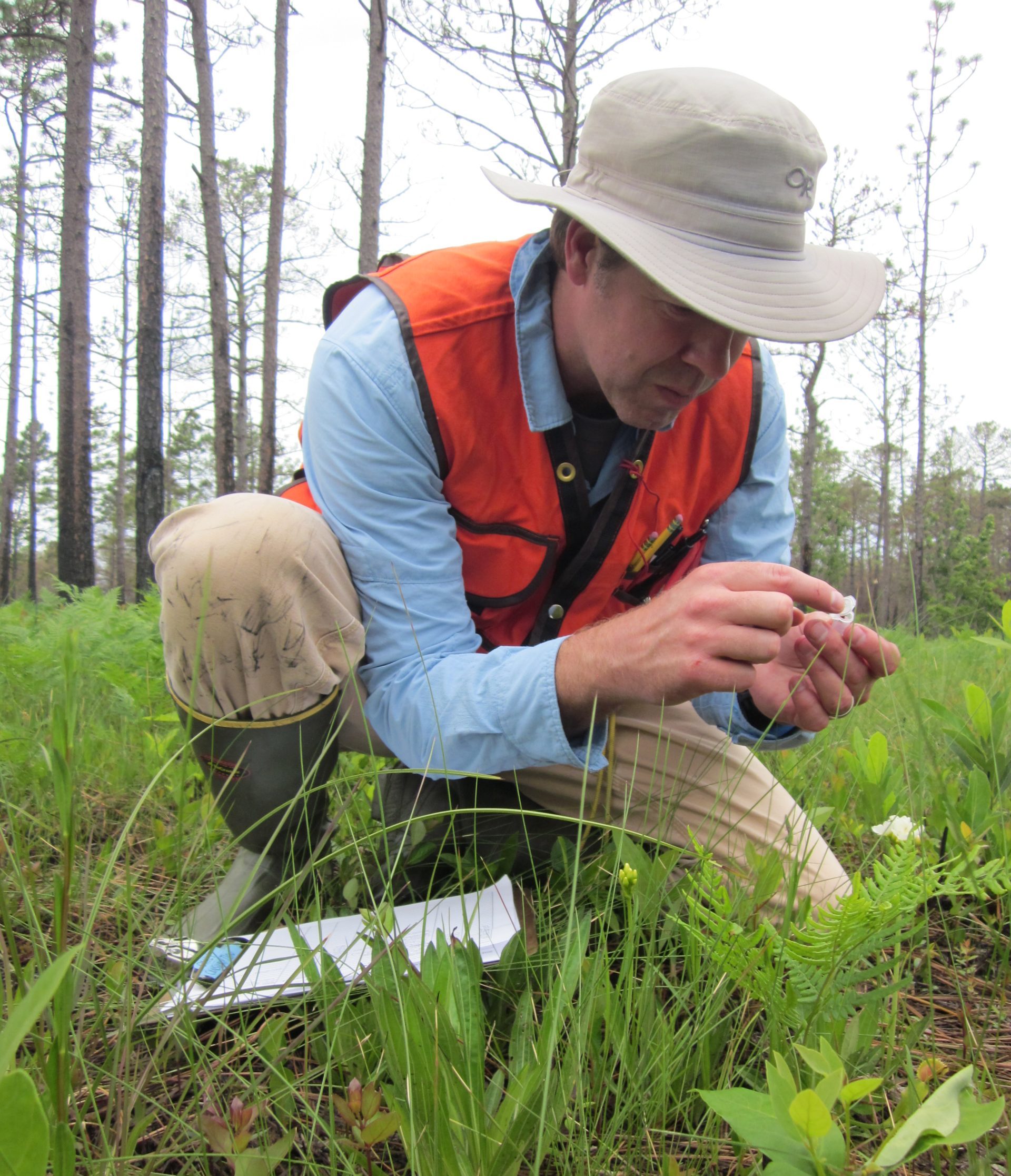
What advice would you give to those who wish to learn more about how they can help save imperiled plant species?
Visit and support botanical gardens and reach out to local conservation organizations – there is a wealth of expertise in these networks. I also think one of the best ways to do more to save plants is to help a diversity of people find their own unique way to connect to a plant, any plant. The more we build a society that values plants at all levels, the more likely we are to advocate for their conservation. So, teach a friend anything cool about a plant and be willing to listen when they tell you their plant stories.
CPC Board of Trustees Welcomes New President & Chair
The Center for Plant Conservation’s (CPC) Board of Trustees is a group of dedicated individuals that each bring to our organization a wealth of knowledge, unique professional experiences, and a profound enthusiasm and commitment to CPC’s mission to safeguard imperiled plants from extinction.
Leading this extraordinary group is CPC’s newly elected Board President & Chair, David Doyle, whose passion for plants and conservation—and long-standing support of CPC—will be a boon to our organization and guide his leadership during an exciting new chapter. David succeeds Dr. Barbara Millen, who served in the role from 2020-2024. We are deeply grateful to both David and Barbara for their stalwart leadership and support!

David Doyle is a retired attorney with a passion for plants and nature conservation residing in San Diego, California. He graduated with a Bachelor of Arts, Magna cum Laude, from the University of California -San Diego (UCSD), and subsequently took a Master of Laws (LLM) degree from the University of California – Los Angeles Law School.
After working in government as a Law Clerk and Assistant U.S. Attorney in the Southern District of California, Mr. Doyle entered private practice specializing in patent litigation. He served as managing partner of the San Diego office of Baker & McKenzie and as Chair of the Patent Group at Morrison & Foerster, where he was named in multiple years by U.S. News & World Report as one of the top ten national patent trial lawyers.
Mr. Doyle has engaged in many community activities, including serving on the Boards of Trustees of the UCSD Alumni Foundation, UCSD CONNECT (a University/ Technology Industry interface organization), the Kyoto Symposium Organization (Board Chair 2015-2022), as well as volunteering with Big Brother San Diego (2008 – 2015). In 2017, he co-chaired the annual Gala of Voices for Children – San Diego with his wife, former Center for Plant Conservation Trustee Nancy Doyle.
“There is an impressive roster of botanic garden and plant conservation groups. Among those, I see the CPC as the one most ‘having its hands in the dirt’: digging into the nitty-gritty to save plants, so I am thrilled to be a part of this dynamic organization and network.” – David Doyle
National Collection Spotlight: Mountain Sweet Pitcherplant
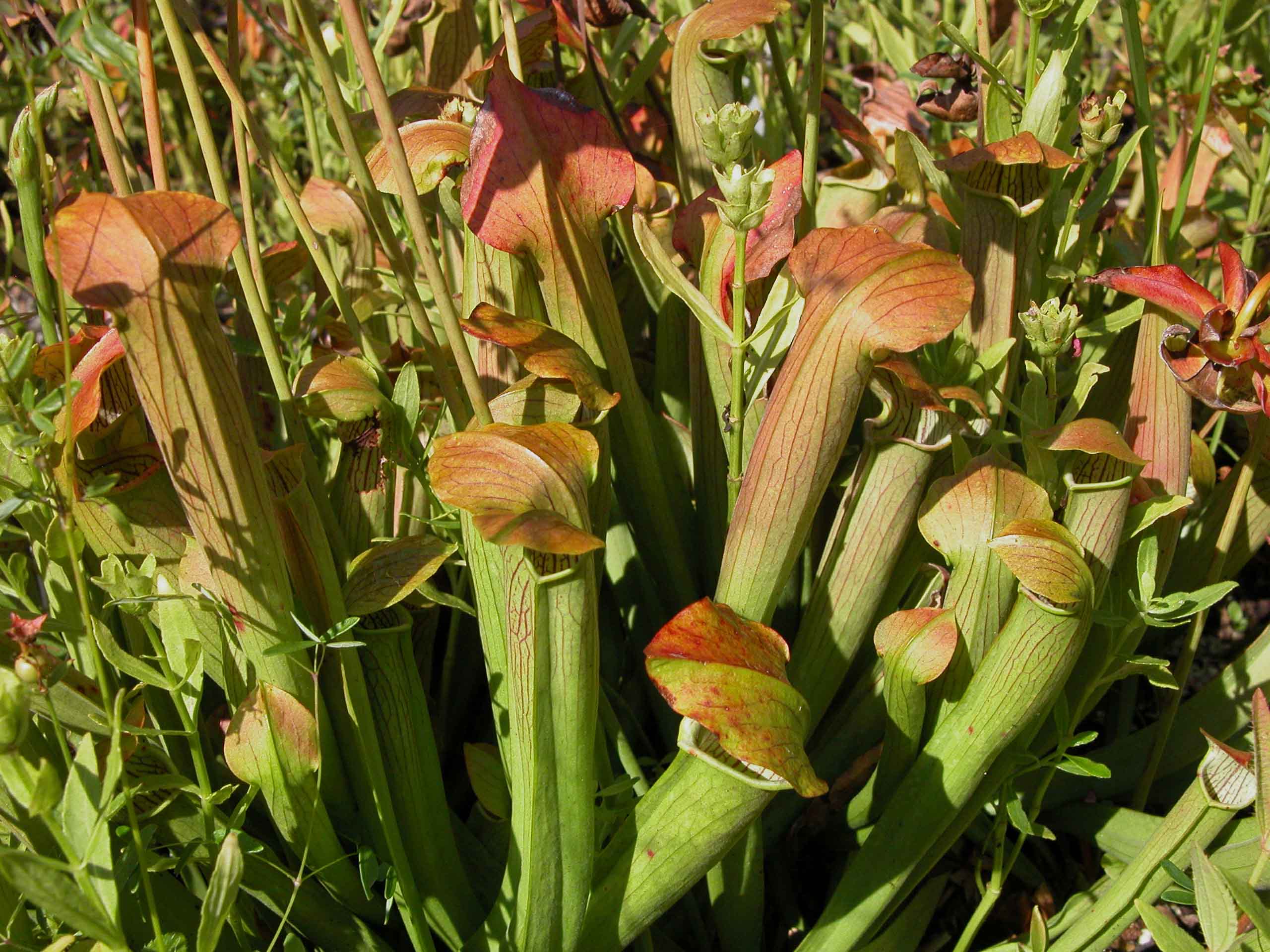
Mountain Sweet Pitcherplant (Sarracenia rubra ssp. jonesii) is a critically imperiled and federally endangered carnivorous plant species endemic to the Blue Ridge Mountains of North and South Carolina. Nestled amidst the sphagnum moss in mountain bogs and along streams, this species is bright green with maroon veins and features clever pitchers to trap its prey — mainly insects and small arthropods that serve to supplement their nutrient-deficient habitat. With waxy, slippery pitchers, their prey cannot escape once captured. The plant produces a nectar that paralyzes its prey, as well as digestive fluids that decompose it, allowing the plant to absorb its nutrients.
This unique plant faces many threats, including changes in hydrology that destroy their bog habitats, as well as fire suppression, fertilizer run-off, and illegal poaching and collecting. The conversion of forested land to use for agriculture or residential and commercial land development leads to changes that impact local streams, thereby drying out these biodiverse bogs that support countless species. Of the 16 historical populations known of this southern Appalachian endemic, only 10 survive today, with two populations on public land — and only one is known to be well protected.
Mountain Sweet Pitcherplant is secured in the National Collection at North Carolina Botanic Gardens and Atlanta Botanical Garden. Conservation initiatives include on-site management, seed collection, and research into propagation and outplanting.
Learn more about conservation actions taken for Mountain Sweet Pitcherplant on its National Collection Plant Profile!
As Seen on the Rare Plant Academy: Range-wide Ex Situ Seed Conservation and Population Genetic Architecture Analysis in Venus Flytrap
CPC’s Best Practices guidelines are brought to life in our Rare Plant Academy (RPA) Video Library, serving to keep the conservation community up-to-date with rapidly evolving technology and advanced methodologies. The RPA Video Library is home to many informational videos on plant conservation topics, from educational videos to case studies and recorded conference presentations.
“Range-wide Ex Situ Seed Conservation and Population Genetic Architecture Analysis in Venus Flytrap (Dionaea muscipula)” was presented by Dr. Johnny Randall of North Carolina Botanical Garden (NCBG) during the 2020 Southeastern Partners in Plant Conservation Conference (SePPCon), providing an in-depth overview on NCBG’s double-pronged conservation approach of collecting and banking seeds by maternal line, and doing genetic analysis across the populations using RADSeq. For even more information on NCBG’s work to preserve the Venus’ Flytrap, watch this video, too!
CPC National Office staff recently attended the 2024 SePPCon in Atlanta, Georgia, and were pleased to connect with so many conservation scientists and practitioners in the Southeast region. Look for 2024 SePPCon presentations on the RPA Video Library coming soon!
Get Updates
Get the latest news and conservation highlights from the CPC network by signing up for our newsletters.
Sign Up Today!Employment Opportunities
Originally posted October 8, 2024 – position will remain open until filled
The Board of Trustees of the Center for Plant Conservation (CPC) seeks a Chief Executive Officer to lead CPC’s operations and strategic initiatives toward achieving significant impact on rare plant conservation and environmental resiliency.
ABOUT CPC
The CPC is a unique network of institutional partners that unites leading plant conservation professionals from botanical gardens & arboreta and other plant- and conservation-focused organizations to work collaboratively to save imperiled plants throughout their native ranges in the United States and Canada.
CPC is based at the Beckman Center for Conservation Research, located on the grounds of the San Diego Zoo Safari Park in Escondido, California, a wildlife and plant conservation center operated by the San Diego Zoo Wildlife Alliance (a CPC Conservation Partner). CPC has an annual operating budget of over $1.7M and works in close collaboration with a network of more than 80 conservation partners.
CPC’s partner institutions maintain the CPC National Collection of Endangered Plants, one of the world’s foremost wild-plant conservation collections. By working to collect and manage living seeds, plants, and tissue taken from imperiled plants, CPC helps secure these species and advances research to further preserve and protect them for future generations. CPC’s annual National Meeting, its website and Rare Plant Academy, publications, and other resources serve to position the organization as a leading voice in the global practice of conservation of plants.
POSITION OVERVIEW
The Center for Plant Conservation seeks a visionary leader to move the organization forward in its mission to conserve imperiled plants and support global environmental resiliency. Working collaboratively with an engaged Board of Trustees, CPC’s CEO is responsible for stewarding the organization’s ongoing operations, member network, long-term strategy, and financial security. Leading a dedicated staff and consultant team, the CEO serves as the voice and face of the organization, frequently communicating with both public and scientific audiences. CPC’s leader oversees the development of CPC programs and maintains strong, mutually reinforcing relationships with a dynamic, cohesive network of partner institutions whose research and initiatives form the foundation of CPC’s impact.
KNOWLEDGE, SKILLS & ABILITIES
The ideal candidate will have at least 5 years of executive leadership experience, including operational and financial oversight, a fundraising track record, and an innovative approach to programming. They must be motivated by a clear and driving passion for nature conservation. Qualified candidates should be knowledgeable about conservation and able to inspire others to understand the value of plant biodiversity. A background in botany/plant science, horticulture, environmental sciences, or a conservation-related field is desirable. Strong interpersonal skills are essential, including staff leadership and development, a collaborative approach with the Board, and the ability to maintain strong relationships with partner institutions and funders. The successful candidate will be a visionary leader with the ability to chart a strategic path forward while providing deep attention to detail necessary for the organization’s success. The ideal CEO will have:
- Significant leadership and management experience in positions of increasing responsibility and authority.
- A commitment to the mission of CPC and the conservation of the natural world, and to advancing diversity, equity and inclusion.
- Experience guiding an organization through periods of change, and in developing strategic plans and making objective, data-driven decisions
- A history of working collaboratively and in a leadership role with an engaged Board.
- Skills in organizational development, administration, and personnel management.
- Excellent oral and written communication skills and demonstrated experience working with the media and speaking with diverse audiences.
- Experience managing a complex budget with multiple funding sources and grant obligations.
- A dedication to fundraising, including donor cultivation, grant writing, and public agency partnerships.
COMPENSATION
A competitive compensation package, including a comprehensive benefits package, will be offered based on experience. The expected annual salary range for this position is $150,000–$170,000. Relocation assistance will be offered if necessary.
LOCATION AND WORKING CONDITIONS
CPC is currently based at the Beckman Center for Conservation Research, located on the grounds of the San Diego Zoo Safari Park in Escondido, California. A hybrid remote/in-office situation is possible. Regular travel is expected. Most work will be in an office setting, using a computer and attending meetings. This is a full time, exempt position.
TO APPLY
Interested candidates should apply by November 15, 2024, for priority consideration. Applications should include a resume and a cover letter describing your qualifications matching the position criteria and what you will bring to the role. Please send complete applications to HR@saveplants.org.
CPC is committed to providing a professional work environment free from discrimination, harassment, and retaliation. CPC is committed to providing equal employment opportunities to all employees and applicants for employment.
HOW YOU WILL IMPACT OUR MISSION
The Researcher II develops programs for scientific research; conducts independent and collaborative research in a specialized area of biological science; and supervises assigned research/laboratory operations. This position reports to Scientist level or higher in the Conservation Science & Wildlife Health department.
WHAT YOU WILL DO
- Develop scientific research programs in a specialized field of study.
- Plan, design, organize, supervise, and conduct independent and collaborative projects.
- Determine study subjects, research parameters and methodology, and cost requirements.
- Evaluate funding sources and obtains necessary funding.
- Oversee and conduct data collection, analysis, and interpretation of results applied to conservation programs.
- Coordinate with animal care and veterinary staff regarding sample collection, disease trends, and reproductive status; provides samples to collaborative researchers.
- Establish research partnerships.
- Oversee assigned area(s) and supervises assigned staff.
WHAT WE ARE LOOKING FOR
The ideal candidate is a Ph.D. level researcher in plant cryobiology with experience developing cryopreservation and micropropagation protocols for conservation genebanking of wild rare plants. The Researcher II will continue research on rare California oaks and expand the plant cryopreservation program to other rare plant taxa, especially orchids, cycad and palms, and train SDZWA staff and partner gardens through workshops in collaboration with other cryobiologists. The successful candidate will coordinate with field and horticulture staff within SDZWA and at collaborating gardens to collect samples for research or accessioning into our cryorepository for long-term conservation. Micropropagation experience with difficult taxa, especially oaks (Quercus), and developing somatic embryos highly desired. We are seeking a researcher with experience in grant reporting, authoring peer-reviewed publications, leading complex multi-year projects with collaborators, and dedicated to the challenge of conserving rare plants through biobanking.
JOB EXPERIENCE
Three years of laboratory, diagnostic, wildlife care or field expertise in a specialized field of research required.
Three years of experience with science communication or interpretation of scientific concepts required.
EDUCATION AND CERTIFICATIONS
Master’s Degree in biological science or a related field or equivalent specialized training required.
Current valid California Driver’s License in good standing
SOME OF THE PERKS YOU WILL ENJOY AS A TEAM MEMBER
Free admission to the San Diego Zoo and the San Diego Zoo Safari Park
Family Passes
Complimentary Tickets
Local and In-House Discounts
Employee Assistance Program
Wellness Program
IMPORTANT DETAILS
Location: Escondido, CA and San Diego, CA
Position Type: Salaried Full-Time Exempt Three Year Position
Salary Range: $86,200 to $95,320
HOW TO APPLY:
Apply directly in our careers page:
https://us241.dayforcehcm.com/CandidatePortal/en-US/sdzwa/Posting/View/19074
The Huntington is seeking a full-time conservation horticulture technician for the cryobiotechnology program, which is one of two research focal areas for the Botanical Division. The job entails a wide range of laboratory activities related to the tissue culture process including making media, initiating plants into the tissue culture system, maintaining a clean laboratory environment, maintaining an in vitro repository of plants, and assisting with the design and execution of controlled experiments.
S/he/they will demonstrate a background of working directly with people from diverse racial, ethnic, geographic and socioeconomic backgrounds, using a welcoming, inclusive, and accessible approach.
Essential Duties
- Assists Cryopreservation Research Botanist under both direct and indirect supervision by working in the Cryobiotechnology labs. Primary duties include preparing media, initiating plant tissue into culture, and assisting with staff research projects (micropropagation, seed and pollen germination tests and cryopreservation experiments).
- Follows SOPs (Standard Operating Procedures), keep exact, detailed records, and collect data.
- Maintains an inventory of chemicals, media, and stock solutions, and safely disposes chemical and biological waste
- Actively propagates living collections through tissue culture system and some greenhouse operations.
- Maintains the in vitro repositories of plants
- Interaction with other staff, Huntington members, and other visitors.
- Some light field work in garden to collect plant material.
Other Functions
Other duties as assigned.
Candidate Requirements and Experience
Knowledge, skills, and abilities:
- Degree (BS or MS) in horticulture, botany or biology strongly preferred.
- Background working with plants in a scientific setting.
- Plant tissue culture experience required, other laboratory experience a plus.
Ways to Help CPC

Conservation Advocacy Initiatives

Donate to Save Endangered Plants
Without plants, life as we know it would not be possible. Yet two in five of the world’s plants are at risk of extinction. More than ever before, rare plants need our help!
When you support the Center for Plant Conservation (CPC) by making a charitable gift, you help advance our mission to safeguard rare plants by advancing science-based conservation practices, connecting and empowering plant conservationists, and inspiring all to protect biodiversity for future generations.
Your donation makes it possible for CPC to offer educational resources that support and train our botanical community, advance science-based conservation research, maintain the National Collection of Rare and Endangered Plants, and so much more.
The Center For Plant Conservation is a 501 (c) (3) non-profit organization (EIN# 22-2527116). Your gift to the Center for Plant Conservation is 100% tax deductible.
Your gift ensures CPC’s meaningful conservation work will continue. Together, we save more plants than would ever be possible alone—ensuring that both plants and people thrive for generations to come. We are very thankful to for all that you do to help us Save Plants!
Donate to CPC
Thank you for helping us save plant species facing extinction by making your gift to CPC through our secure donation portal!
Donate Today
